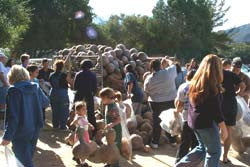How Gourds are Grown
Gourd Growing Info and Timeline
Did you know that it takes one full year to grow gourds? While some crops are planted and harvested in as little as 90 days, gourds are a completely different story. On this page, we'll show you what our year looks like at the Farm.
March
These gourd plants are 4 weeks old.
April
Plants continue to grow and begin to set fruit. At 10 weeks, the gourd vines have almost completely closed the gap between rows. Some vines grow longer than 50 feet!
May-July
Pictured above: Phoebe Welburn showing a very young gourd. Most of the gourds that grow to maturity are pollinated during this time. The later in the season the gourd is pollinated, the less likely the chances that it will be mature enough to cure when the vine freezes in winter. (Gourds that have not matured will rot at that point).
Here is a female flower with the small gourd fruit at the base.
May-November
This is the main growing period for the plants and gourds. The gourds that were the earliest to be pollinated will grow the largest in their respective size-classes. (For example, a mini gourd seed can never grow to be the size of a Giant gourd, but the first-pollinated will be the largest in the Mini-gourd class). By August, many gourds are nearly mature. Gourds are pale green in color and very heavy like a pumpkin when they are growing.
Shown above: Gourd with white wash on it
to protect it from sun damage as it dries.
Occasionally a very hot summer will weaken the gourd plants and knock down many of the broad leaves that serve to keep the gourds protected. Whitewash serves to protect these exposed gourds.
When this happens, the entire Welburn Gourd Farm crew takes to the fields with buckets of whitewash to paint a protective, white shield on every exposed gourd. (The paint is water soluble, and what is not washed off in the winter rains comes off easily when the gourds are cleaned.)
To help with protecting the gourds from sun damage, hoops are set up that the vines can grow on and provide natural shelter, thus reducing the need to "white wash" the gourds as shown in the previous photo.
Mid-November

Gourd field just after frost has knocked down the vines.
Late November
Gourds can now be cut from the vines. There is no mechanical harvesting method. Every gourd must be cut from the vine by hand! (If you are growing gourds at home, you can cut your gourds from the vine as soon as the stem has begun to turn brown at the base). Gourds just cut from the vine and placed in long rows, called windrows, for drying. At this stage the gourds will have often have big dark spots and almost look like they are rotting.
The waxy skin peeling away during drying.
The warm days and cold nights of Southern California's winter help break down the waxy cuticle layer on the outside of the gourd. Gourds grown in other climate zones do not have this advantage and the waxy skin hardens on the gourd as it dries and takes a lot of time and hard scrubbing to remove! One of the reasons Welburn Gourds are so popular is because they are so easy to clean -- just scrub off the dirt and mold and you're done!


November-February
Pictured above: Doug Welburn inspects a gourd crop as it dries. It takes approximately four months for the gourds to dry. To keep the gourds from cracking and to ensure even drying, every gourd is picked up and individually turned by hand 2-3 times during the drying season!
To give you an idea what this involved, it takes a crew of 6 men working all day for 5 weeks just to turn the crop one time!
March - Harvest Time
By late February, most of the gourds are dry and ready to be harvested.
The gourds are brought in from the fields and piled in the gourd racks for customers to purchase. The gourds in racks under the oak trees -- not only protects them from the sun, but you as well while you are shopping for the perfect gourds!
Customers come from all over the world to shop at the Farm in Fallbrook, CA.
In addition to the gourd racks being filled in March when the new crop is harvested, they are also periodically filled throughout the year. This helps guarantee a great selection of gourds for the majority of the year.

Eager crowd pulling gourds from our harvest trailer.
End of March- Beginning of April:
Gourds Shipped to Your Door:
